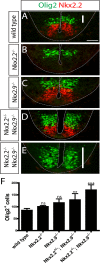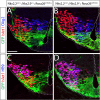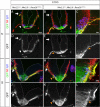Nkx2.2 and Nkx2.9 are the key regulators to determine cell fate of branchial and visceral motor neurons in caudal hindbrain
- PMID: 25919494
- PMCID: PMC4412715
- DOI: 10.1371/journal.pone.0124408
Nkx2.2 and Nkx2.9 are the key regulators to determine cell fate of branchial and visceral motor neurons in caudal hindbrain
Abstract
Cranial motor nerves in vertebrates are comprised of the three principal subtypes of branchial, visceral, and somatic motor neurons, which develop in typical patterns along the anteroposterior and dorsoventral axes of hindbrain. Here we demonstrate that the formation of branchial and visceral motor neurons critically depends on the transcription factors Nkx2.2 and Nkx2.9, which together determine the cell fate of neuronal progenitor cells. Disruption of both genes in mouse embryos results in complete loss of the vagal and spinal accessory motor nerves, and partial loss of the facial and glossopharyngeal motor nerves, while the purely somatic hypoglossal and abducens motor nerves are not diminished. Cell lineage analysis in a genetically marked mouse line reveals that alterations of cranial nerves in Nkx2.2; Nkx2.9 double-deficient mouse embryos result from changes of cell fate in neuronal progenitor cells. As a consequence progenitors of branchiovisceral motor neurons in the ventral p3 domain of hindbrain are transformed to somatic motor neurons, which use ventral exit points to send axon trajectories to their targets. Cell fate transformation is limited to the caudal hindbrain, as the trigeminal nerve is not affected in double-mutant embryos suggesting that Nkx2.2 and Nkx2.9 proteins play no role in the development of branchiovisceral motor neurons in hindbrain rostral to rhombomere 4.
Conflict of interest statement
Figures








References
-
- Kandel ER, Schwartz JH, Jessell TM. Principles of neural science. 4th ed ed. New York: McGraw-Hill; 2000.
Publication types
MeSH terms
Substances
LinkOut - more resources
Full Text Sources
Other Literature Sources
Molecular Biology Databases
Research Materials

